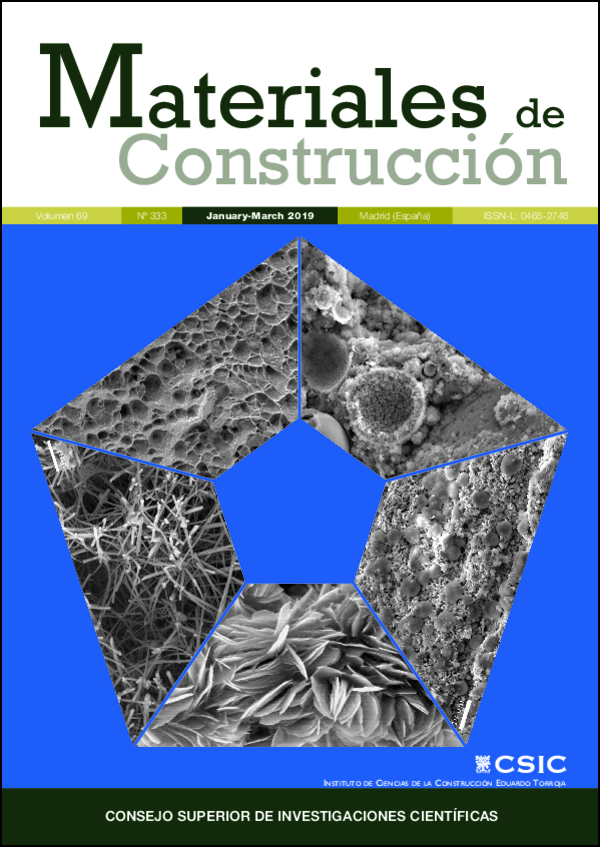Fabricación de cerámicas con altas propiedades mecánicas a partir de lodo rojo y residuo de granito
DOI:
https://doi.org/10.3989/mc.2019.03818Palabras clave:
Cerámica, Caracterización, Resistencia a la flexión, Propiedades mecánicas, Microscopía electrónica de barrido (MEB)Resumen
El residuo de bauxita (lodo rojo) es una suspensión alcalina generada durante el proceso Bayer de producción de alúmina. La elevada producción anual e inventario global determinan su valorización. El granito puede usarse como fuente de óxidos fundentes para la industria cerámica y del mismo modo, el residuo en esquirlas generadas durante el flameado del granito. En este trabajo, se preparan una serie de piezas a partir de lodo rojo y residuo de granito, caracterizadas mediante difracción de rayos X, dureza, microscopía electrónica de barrido y lixiviación, determinando porosidad abierta, absorción de agua, densidad y resistencia a la flexión de las muestras. Las principales fases cristalinas en los productos fabricados a alta temperatura son hematita, pseudobrookita y anortita; la presencia de magnetita revela su carácter ferrimagnético. Todas las muestras presentan elevadas propiedades mecánicas. Los resultados del análisis de lixiviados están por debajo de los niveles críticos establecidos en normativa.
Descargas
Citas
Xue, S.; Zhu, F.; Kong, X.; Wu, C.; Huang, L.; Huang, N.; Hartley, W. (2016) A review of the characterization and revegetation of bauxite residues (Red mud). Environ. Sci. Pollut. Res. Int. 23 [2], 1120-1132. https://doi.org/10.1007/s11356-015-4558-8 PMid:25911289
Report of the 28th meeting of the scientific group, International Maritime Organization Publishing, London (UK), (2005).
Dauvin, J.C. (2010) Towards an impact assessment of bauxite red mud waste on the knowledge of the structure and functions of bathyal ecosystems: The example of the Cassidaigne canyon (North-Western Mediterranean Sea). Mar. Pollut. Bull. 60 [2], 197-206. https://doi.org/10.1016/j.marpolbul.2009.09.026 PMid:19837438
Fabri, M.C.; Pedel, L.; Beuck, L.; Galgani, F.; Hebbeln, D.; Freiwald, A. (2014) Megafauna of vulnerable marine ecosystems in French mediterranean submarine canyons: Spatial distribution and anthropogenic impacts. Deep Sea Res. II 104, 184-207. https://doi.org/10.1016/j.dsr2.2013.06.016
Fontanier, C.; Fabri, M.C.; Buscail, R.; Biscara, L.; Koho, K.; Reichart, G.J.; Cossa, D.; Galaup, S.; Chabaud, G.; Pigot, L. (2012) Deep-sea foraminifera from the Cassidaigne Canyon (NW Mediterranean): Assessing the environmental impact of bauxite red mud disposal. Mar. Pollut. Bull. 64 [9], 1895-1910. https://doi.org/10.1016/j.marpolbul.2012.06.016 PMid:22795490
Czövek, D.; Novák, Z.; Somlai, C.; Asztalos, T.; Tiszlavicz, L.; Bozóki, Z.; Ajtai, T.; Utry, N.; Filep, A.; Bari, F.; Peták, F. (2012) Respiratory consequences of red sludge dust inhalation in rats. Toxicol. Lett. 209 [2], 113-120. https://doi.org/10.1016/j.toxlet.2011.12.006 PMid:22209771
Mi_ík, M.; Burke, I.T.; Reismu_ller, M.; Pichler, C.; Rainer, B.; Mi_íková, K.; Mayes, W.M.; Knasmueller, S. (2014) Red mud a byproduct of aluminum production contains soluble vanadium that causes genotoxic and cytotoxic effects in higher plants. Sci. Total Environ. 493, 883-890. https://doi.org/10.1016/j.scitotenv.2014.06.052 PMid:25000584
Li, G.; Liu, M.; Rao, M.; Jiang, T.; Zhuang, J.; Zhang, Y. (2014) Stepwise extraction of valuable components from red mud based on reductive roasting with sodium salts. J. Hazard. Mater. 280, 774-780 https://doi.org/10.1016/j.jhazmat.2014.09.005 PMid:25240647
Liu, Y.; Zhao, B.; Tang, Y.; Wan, P.; Chen, Y.; Lv, Z. (2014) Recycling of iron from red mud by magnetic separation after co-roasting with pyrite. Thermochim. Acta 588, 11-15. https://doi.org/10.1016/j.tca.2014.04.027
Zhang, R.; Zheng, S.; Ma, S.; Zhang, Y. (2011) Recovery of alumina and alkali in Bayer red mud by the formation of andradite-grossular hydrogarnet in hydrothermal process. J. Hazard. Mater. 189 [3], 827-835. https://doi.org/10.1016/j.jhazmat.2011.03.004 PMid:21444152
González-Trivi-o, I.; Benítez-Guerrero, M.; Carda Castelló, J.B.; Moreno, B.; Pascual-Cosp, J. (2018) Synthesis and characterization of ferrimagnetic glassceramic frit from waste. Int. J. Appl. Ceram. Technol. 15 [3], 775-782. https://doi.org/10.1111/ijac.12850
Kehagia, F. (2010) A successful pilot project demonstrating the re-use potential of bauxite residue in embankment construction. Resour. Conserv. Recycl. 54 [7], 417-421. https://doi.org/10.1016/j.resconrec.2009.10.001
Gray, C.W.; Dunham, S.J.; Dennis, P.G.; Zhao, F.J.; McGrath, S.P. (2006) Field evaluation of in situ remediation of a heavy metal contaminated soil using lime and red-mud. Environ. Pollut. 142 [3], 530-539. https://doi.org/10.1016/j.envpol.2005.10.017 PMid:16321462
Huang, W.; Wang, S.; Zhu, Z.; Li, L.; Yao, X.; Rudolph, V.; Haghseresht, F. (2008) Phosphate removal from wastewater using red mud. J. Hazard. Mater. 158 [1], 35-42. https://doi.org/10.1016/j.jhazmat.2008.01.061 PMid:18314264
Pontikes, Y.; Angelopoulos, G.N. (2013) Bauxite residue in cement and cementitious applications: Current status and a possible way forward. Resour. Conserv. Recycl. 73, 53-63. https://doi.org/10.1016/j.resconrec.2013.01.005
Rai, S.; Lataye, D.H.; Chaddha, M.J.; Mishra, R.S.; Mahendiran, P.; Mukhopadhyay, J.; Yoo, C.K.; Wasewar, K.L. (2013) An Alternative to Clay in Building Materials: Red Mud Sintering Using Fly Ash via Taguchi's Methodology. Adv. Mater. Sci. Eng. 2013, Article ID 757923. https://doi.org/10.1155/2013/757923
Pérez-Villarejo, L.; Corpas-Iglesias, F.A.; Martínez-Martínez, S.; Artiaga, R.; Pascual-Cosp, J. (2012) Manufacturing new ceramic materials from clay and red mud derived from the aluminium industry. Constr. Build. Mater. 35, 656-665. https://doi.org/10.1016/j.conbuildmat.2012.04.133
Singh, S.; Nagar, R.; Agrawal, V.; Rana, A. (2015) Utilization of granite cutting waste in concrete as partial replacement of sand. Conference paper: UKIERI Concrete Congress - Concrete Research Driving Profit and Sustainability, Jalandhar, India.
Ashmole, I.; Motloung, M. (2008) Dimension stone: the latest trends in exploration and production technology. Conference paper: The international conference in surface mining, Johannesburg, South Africa.
Hamza, R.A.; El-Haggar, S.; Khedr, S. (2011) Marble and granite waste: characterization and utilization in concrete bricks. Int. J. Biosci. Biochem. Bioinforma. 1 [4], 286-291. https://doi.org/10.7763/IJBBB.2011.V1.54
González-Trivi-o, I.; Benítez-Guerrero, M.; Moreno, B.; Pascual-Cosp, J. (2018) Ferrimagnetic wollastonite ceramics based on waste valorization. Int. J. Appl. Ceram. Technol. 00, 1-6.
Committee AEN/CTN 138. (2014). UNE-EN ISO 10545- 4:2014. Ceramic tiles. Part 4: Determination of modulus of rupture and breaking strength. Madrid: AENOR. 23. Committee AEN/CTN 264. (20015). UNE-EN 843-4:2005. Advanced technical ceramics. Mechanical properties of monolithic ceramics at room temperature. Part 4: Vickers, Knoop and Rockwell superficial hardness tests. Madrid: AENOR.
Committee ISO/TC 189. (2018). ISO 10545-3:2018. Ceramic tiles. Part 3: Determination of water absorption, apparent porosity, apparent relative density and bulk density. Switzerland: International Organization for Standardization.
Committee AEN/CTN 77. (2002). UNE-EN 12457-4:2002. Characterization of waste. Leaching. Compliance for leaching of granular waste materials and sludges. Part 4: One stage batch test at a liquid to solid ratio of 10 L/kg for materials with particle size below 10 mm (without or with size reduction). Madrid: AENOR.
Torres, P.; Manjate, R.S.; Quaresma, S.; Fernandes, H.R.; Ferreira, J.M.F. (2007) Development of ceramic floor tile compositions based on quartzite and granite sludges. J. Eur. Ceram. Soc. 27 [16], 4649-4655. https://doi.org/10.1016/j.jeurceramsoc.2007.02.217
Zhao, L.; Li, Y.; Jiang, F.; Cang, D. (2016) Effects of compositionchanges on the sintering properties of novel Steel slag ceramics. In: Advances in materials science for environmental and energy technologies V, John Wiley & Sons, Inc., Hoboken, New Jersey (USA), (2016).
Barrios de Arenas, I.; Arenas, F.; Cho, S.A.; Martínez, S.; Sicardi, R. (2000) Efecto de los aditivos en la formación y estabilidad térmica a baja temperatura del titanato de aluminio. Bol. Soc. Esp. Ceram. V. 39 [6], 699-703 (In Spanish). https://doi.org/10.3989/cyv.2000.v39.i6.768
Kato, E., Daimon, K., Takahashi, J. (1980) Decomposition Temperature of b-Al2TiO5. J. Am. Ceram. Soc. 63 [5-6], 355-356. https://doi.org/10.1111/j.1151-2916.1980.tb10745.x
Zhang, D. (2013) Ultra-supercritical coal power plants. Materials, technologies and optimisation, Woodhead publishing limited, Cambridge (UK), (2013). https://doi.org/10.1533/9780857097514
Özdemir, Ö., Dunlop, D.J. (2000) Intermediate magnetite formation during dehydration of goethite. Earth Planet Sci. Lett. 177 [1-2], 59-67. https://doi.org/10.1016/S0012-821X(00)00032-7
Watanabe, Y., Ishii, K. (1995) Geometrical consideration of the crystallography of the transformation from a-Fe2O3 to Fe3O4. Phys. Stat. Solids 150 [2], 673-686. https://doi.org/10.1002/pssa.2211500210
Guidelines for drinking-water quality, World Health Organization, Geneva (CH), (2011).
Publicado
Cómo citar
Número
Sección
Licencia
Derechos de autor 2019 Consejo Superior de Investigaciones Científicas (CSIC)

Esta obra está bajo una licencia internacional Creative Commons Atribución 4.0.
© CSIC. Los originales publicados en las ediciones impresa y electrónica de esta Revista son propiedad del Consejo Superior de Investigaciones Científicas, siendo necesario citar la procedencia en cualquier reproducción parcial o total.
Salvo indicación contraria, todos los contenidos de la edición electrónica se distribuyen bajo una licencia de uso y distribución “Creative Commons Reconocimiento 4.0 Internacional ” (CC BY 4.0). Consulte la versión informativa y el texto legal de la licencia. Esta circunstancia ha de hacerse constar expresamente de esta forma cuando sea necesario.
No se autoriza el depósito en repositorios, páginas web personales o similares de cualquier otra versión distinta a la publicada por el editor.
















